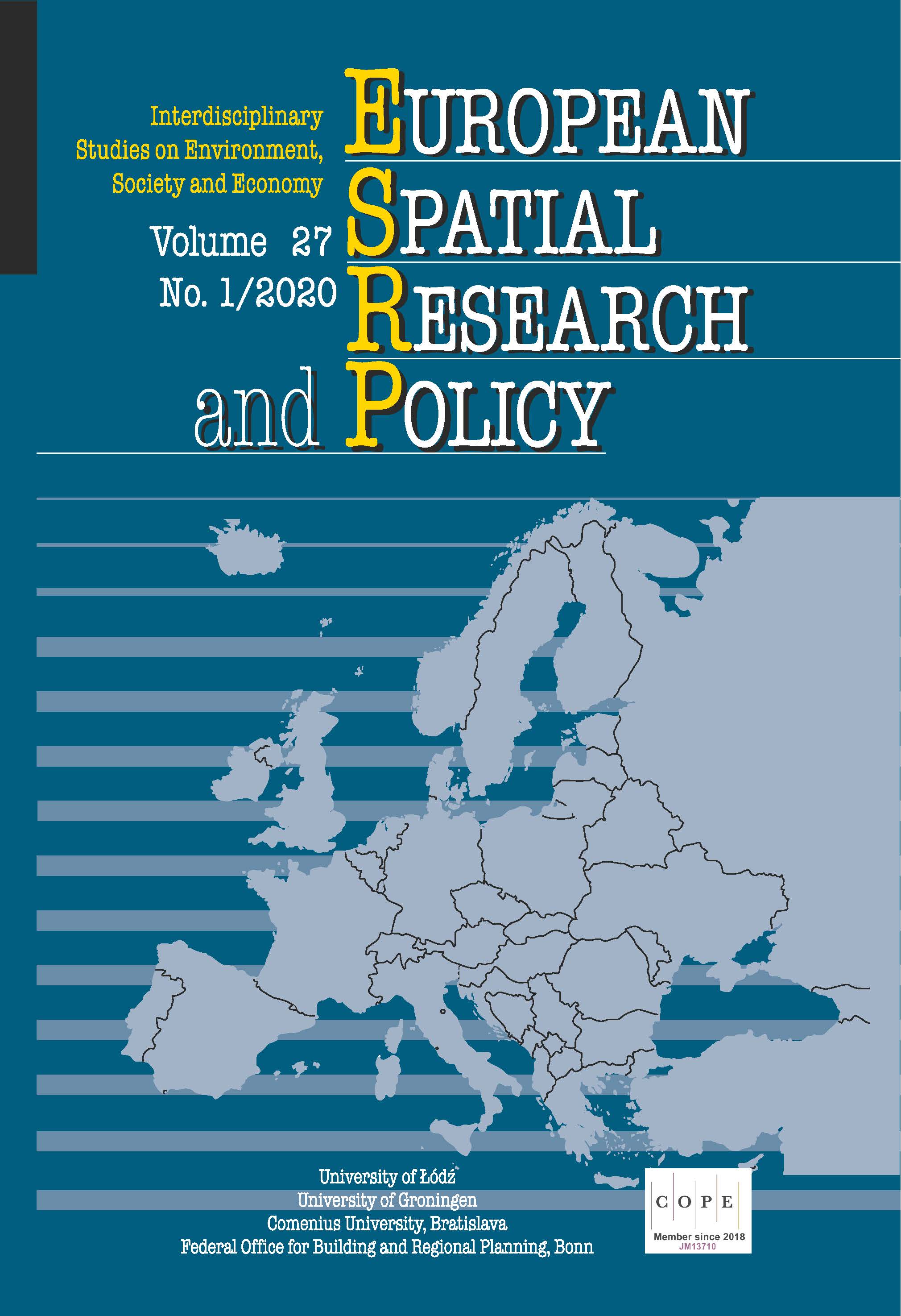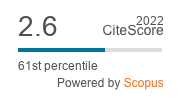Coworking Spaces as a Driver of the Post-Fordist City: a Tool for Building a Creative Ecosystem
DOI:
https://doi.org/10.18778/1231-1952.27.1.05Keywords:
coworking spaces, coworking, creative ecosystem, creative industries, post-Fordist cityAbstract
Collaborative places nurture creativity and efficiency of cultural and creative industries. Research in collaborative places revealed they are essential for networking and cooperation in the creative ecosystem. The results of studies focusing on competitiveness of coworking spaces and their effect on boosting entrepreneurship are rather vague. Furthermore, an awareness of how coworking spaces stimulate coworkers to engage in urban regeneration through local community initiatives is limited. Hence, this study seeks to provide an insight into coworking spaces from the organizational perspective devoted to entrepreneurship and competitiveness. Simultaneously, the paper aims to reveal synergies between creative communities and local development. The method of data gathering consists of semi-structured in-depth interviews with managers and entrepreneurs from selected countries of the EU applying the grounded theory for their analysis. The results suggest that coworking spaces indicate a boosting of the entrepreneurship of the creative class through collective projects. These activities tend to stimulate knowledge creation and open innovation in the creative ecosystem that benefit local development. Coworking spaces also represent a driving force to initiate and maintain a dialogue between the creative ecosystem and local authorities for culture-led urban development.
Downloads
References
AMIN, A. (2011), Post-Fordism: a reader, John Wiley & Sons.
Google Scholar
ASHEIM, B. (2012), ‘The changing role of learning regions in the globalizing knowledge economy: A theoretical re-examination’, Regional Studies, 46 (8), pp. 993–1004. https://doi.org/10.1080/00343404.2011.607805
Google Scholar
DOI: https://doi.org/10.1080/00343404.2011.607805
BABB, C., CURTIS, C. and MCLEOD, S. (2018), ‘The Rise of Shared Work Spaces: A Disruption to Urban Planning Policy?’, Urban Policy and Research, 36 (4), pp. 496–512. https://doi.org/10.1080/08111146.2018.1476230
Google Scholar
DOI: https://doi.org/10.1080/08111146.2018.1476230
BATHELT, H., MALMBERG, A. and MASKELL, P. (2004), ‘Clusters and knowledge: local buzz, global pipelines and the process of knowledge creation’, Progress in human geography, 28 (1), pp. 31–56. https://doi.org/10.1191/0309132504ph469oa
Google Scholar
DOI: https://doi.org/10.1191/0309132504ph469oa
BEREITSCHAFT, B. and CAMMACK, R. (2015), ‘Neighborhood diversity and the creative class in Chicago’, Applied Geography, 63, pp. 166–183. https://doi.org/10.1016/j.apgeog.2015.06.020
Google Scholar
DOI: https://doi.org/10.1016/j.apgeog.2015.06.020
BIRKS, D.F., FERNANDEY, W. and LEVINA, N. (2013) ‘Grounded theory method in information systems research: its nature, diversity and opportunities’, European Journal of Information Systems, 22 (1), pp. 1–8. https://doi.org/10.1057/ejis.2012.48
Google Scholar
DOI: https://doi.org/10.1057/ejis.2012.48
BOUNCKEN, R.B. and REUSCHL, A.J. (2018),’ Coworking-spaces: how a phenomenon of the sharing economy builds a novel trend for the workplace and for entrepreneurship’, Review of Managerial Science, 12 (1), pp. 317–334. https://doi.org/10.1007/s11846-016-0215-y
Google Scholar
DOI: https://doi.org/10.1007/s11846-016-0215-y
BROWN, J. (2017), ‘Curating the ‘third place’? Coworking and the mediation of creativity’, Geoforum: Journal of Physical, Human, and Regional Geosciences, 82, pp. 112–126. https://doi.org/10.1016/j.geoforum.2017.04.006
Google Scholar
DOI: https://doi.org/10.1016/j.geoforum.2017.04.006
CAPDEVILA, I. (2013), Knowledge dynamics in localized communities: Coworking spaces as microclusters, Retrieved from: https://papers.ssrn.com/sol3/papers.cfm?abstract_id=2414121 https://doi.org/10.2139/ssrn.2414121
Google Scholar
DOI: https://doi.org/10.2139/ssrn.2414121
CAPDEVILA, I. (2015), ‘Co-working spaces and the localised dynamics of innovation in Barcelona’, International Journal of Innovation Management, 19 (03), pp. 1–25. https://doi.org/10.1142/S1363919615400046
Google Scholar
DOI: https://doi.org/10.1142/S1363919615400046
CHAPAIN, C., COOKE, P., DE PROPRIS, L., MACNEILL, S. and MATEOS-GARCIA, J. (2010), Creative clusters and innovation: Putting creativity on the map, NESTA London.
Google Scholar
CLIFTON, N. (2008), ‘The «creative class» in the UK: an initial analysis’, Geografiska Annaler: Series B, Human Geography, 90 (1), pp. 63–82. https://doi.org/10.1111/j.1468-0467.2008.00276.x
Google Scholar
DOI: https://doi.org/10.1111/j.1468-0467.2008.00276.x
COLLINS, C.J. and SMITH, K.G. (2006), ‘Knowledge exchange and combination: The role of human resource practices in the performance of high-technology firms’, Academy of Management Journal, 49 (3), pp. 544–560. https://doi.org/10.5465/amj.2006.21794671
Google Scholar
DOI: https://doi.org/10.5465/amj.2006.21794671
COMUNIAN, R., CHAPAIN, C. and CLIFTON, N. (2014),’Creative industries & creative policies: A European perspective?’, City, Culture and Society, 2 (5), pp. 51–53. https://doi.org/10.1016/j.ccs.2014.05.009
Google Scholar
DOI: https://doi.org/10.1016/j.ccs.2014.05.009
COOKE, P. (2018), ‘Generative growth with ‘thin’ globalization: Cambridge’s crossover model of innovation’, European Planning Studies, 26 (9), pp. 1815–1834. https://doi.org/10.1080/09654313.2017.1421908
Google Scholar
DOI: https://doi.org/10.1080/09654313.2017.1421908
COPERCINI, M. (2016), ‘Berlin as a creative field: Deconstructing the role of the urban context in creative production’, Quaestiones Geographicae, 35 (4), pp. 121–132. https://doi.org/10.1515/quageo-2016-0040
Google Scholar
DOI: https://doi.org/10.1515/quageo-2016-0040
CRUZ, A.R., ALMEIDA, R.M., COSTA, P., GATO, M.A. and PERESTRELO, M. (2019), ‘Knowledge Transfer in the Cultural and Creative Sector: Institutional Aspects and Perspectives from Actors in Selected Atlantic Regions’, Social Sciences, 8 (3), p. 77. https://doi.org/10.3390/socsci8030077
Google Scholar
DOI: https://doi.org/10.3390/socsci8030077
CZUPICH, M. (2018), ‘Level of Social Participation in the Creation of Urban Regeneration Programmes – The Case Study of Small Towns in Poland’, European Spatial Research and Policy, 25 (2), pp. 81–98. https://doi.org/10.18778/1231-1952.25.2.05
Google Scholar
DOI: https://doi.org/10.18778/1231-1952.25.2.05
DEFILLIPPI, R. (2015), Managing project-based organization in creative industries, The Oxford handbook of creative industries, pp. 268–283.
Google Scholar
DEPARTMENT OF CULTURE, MEDIA AND SPORT (1998), Creative Industries Mapping Document, 1998, DCMS, London. Retrieved from: http://www.culture.gov.uk/Reference_library/Publications/archive_1998/Creative_Industries_Mapping_Document_1998.html
Google Scholar
DE PROPRIS, L. (2013), ‘How are creative industries weathering the crisis?’, Cambridge Journal of Regions, Economy and Society, 6 (1), pp. 23–35. https://doi.org/10.1093/cjres/rss025
Google Scholar
DOI: https://doi.org/10.1093/cjres/rss025
DI MARINO, M. and LAPINTIE, K. (2017), ‘Emerging workplaces in post-functionalist cities’, Journal of Urban Technology, 24 (3), pp. 5–25. https://doi.org/10.1080/10630732.2017.1297520
Google Scholar
DOI: https://doi.org/10.1080/10630732.2017.1297520
DURANTE, G. and TURVANI, M. (2018), ‘Coworking, the Sharing Economy, and the City: Which Role for the «Coworking Entrepreneur»?’, Urban Science, 2 (3), p. 83. https://doi.org/10.3390/urbansci2030083
Google Scholar
DOI: https://doi.org/10.3390/urbansci2030083
EUROPEAN COMMISSION (2010), Unlocking the Potential of Cultural and Creative Industries, Brussels.
Google Scholar
FARINA, M.C., NETO, A.F., CARVALHO, A.A. and BERNE, D.F. (2018), ‘Coworking and the Generation of Employment and Income’, International Conference on Innovation, Engineering and Entrepreneurship, Springer, Cham, pp. 898–904. https://doi.org/10.1007/978-3-319-91334-6_123
Google Scholar
DOI: https://doi.org/10.1007/978-3-319-91334-6_123
FLORIDA, R. (2002), The rise of the creative class: and how it’s transforming work, leisure, community and everyday life, Basic books, New York.
Google Scholar
FLORIDA, R., MELLANDER, C. and RENTFROW, P. (2013), ‘The happiness of cities’, Regional Studies, 47 (4), pp. 613–627. https://doi.org/10.1080/00343404.2011.589830
Google Scholar
DOI: https://doi.org/10.1080/00343404.2011.589830
FUZI, A. (2015), ‘Co-working spaces for promoting entrepreneurship in sparse regions: the case of South Wales’, Regional Studies, Regional Science, 2 (1), pp. 462–469. https://doi.org/10.1080/21681376.2015.1072053
Google Scholar
DOI: https://doi.org/10.1080/21681376.2015.1072053
GLASER, B., WALSH, I., BAILYN, L., FERNADEZ, W., HOLTON, J. and LEVINA, N. (2013), ‘What Grounded Theory Is’, Academy of Management Proceedings, Briarcliff Manor, New York. https://doi.org/10.5465/ambpp.2013.11290symposium
Google Scholar
DOI: https://doi.org/10.5465/ambpp.2013.11290symposium
HAYTON, J.C. (2003), ‘Strategic human capital management in SMEs: An empirical study of entrepreneurial performance’, Human Resource Management, 42 (4), pp. 375–391. https://doi.org/10.1002/hrm.10096
Google Scholar
DOI: https://doi.org/10.1002/hrm.10096
HEERDEN, S. and BONTJE, M. (2014), ‘What about culture for the ordinary workforce? A study on the locational preferences of the creative class in Prenzlauer Berg, Berlin’, Journal of Urban Affairs, 36 (3), pp. 465–481. https://doi.org/10.1111/juaf.12048
Google Scholar
DOI: https://doi.org/10.1111/juaf.12048
HOWKINS, J. (2002), The creative economy: How people make money from ideas, Penguin UK.
Google Scholar
JACKSON, S.E., DENISI, A. and HITT, M.A. (2003), Managing knowledge for sustained competitive advantage: Designing strategies for effective human resource management, John Wiley & Sons.
Google Scholar
JONES, C., LORENZEN, M. and SAPSED, J. (2015), The Oxford handbook of creative industries, Oxford University Press. https://doi.org/10.1093/oxfordhb/9780199603510.001.0001
Google Scholar
DOI: https://doi.org/10.1093/oxfordhb/9780199603510.001.0001
JONES, C., SVEJENOVA, S. and STRANDGAARD, J. (2011), ‘Misfits, mavericks and mainstreams: Drivers of innovation in creative industries’, Organization Studies, 32 (9), pp. 1308–1310. https://doi.org/10.1177/0170840611424019
Google Scholar
DOI: https://doi.org/10.1177/0170840611424019
KAGAN, S. and HAHN, J. (2011), ‘Creative cities and (un) sustainability: from creative class to sustainable creative cities’, Culture and Local Governance, 3 (1), pp. 11–27. https://doi.org/10.18192/clg-cgl.v3i1.182
Google Scholar
DOI: https://doi.org/10.18192/clg-cgl.v3i1.182
KANNAN, G. and AULBUR, W.G. (2004), ‘Intellectual capital: measurement effectiveness’. Journal of Intellectual Capital, 5 (3), pp. 389–413. https://doi.org/10.1108/14691930410550363
Google Scholar
DOI: https://doi.org/10.1108/14691930410550363
KATZ, B., VEY, J.S. and WAGNER, J. (2015), ‘One year after: Observations on the rise of innovation district Brookings’, June 24, 2015. Retrieved from: https://www.brookings.edu/research/one-year-after-observations-on-therise-of-innovation-districts/
Google Scholar
KLOUDOVÁ, J. and CHWASZCZ, O. (2012), ‘Transformation of 3T model towards the comparison of creative centres within the European Union’, Ekonomie+Management, 20 (32), pp. 56–70.
Google Scholar
KOJO, I. and NENONEN, S. (2017), ‘Evolution of co-working places: drivers and possibilities’, Intelligent Buildings International, 9 (3), pp. 164–175. https://doi.org/10.1080/17508975.2014.987640
Google Scholar
DOI: https://doi.org/10.1080/17508975.2014.987640
KUBÁTOVÁ, J. (2016), ‘Human capital of the 21st century in coworking centers’, Proceeding of ECIC 2016 8th European Conference on Intellectual Capital, pp. 145–151.
Google Scholar
LAWTON, P., MURPHY, E. and REDMOND, D. (2013), ‘Residential preferences of the ‘creative class’?’, Cities, 31, pp. 47–56. https://doi.org/10.1016/j.cities.2012.04.002
Google Scholar
DOI: https://doi.org/10.1016/j.cities.2012.04.002
LEAVY, P. (2014), The Oxford handbook of qualitative research, Oxford library of psychology. https://doi.org/10.1093/oxfordhb/9780199811755.001.0001
Google Scholar
DOI: https://doi.org/10.1093/oxfordhb/9780199811755.001.0001
MARIOTTI, I., PACCHI, C. and DI VITA, S. (2017), ‘Co-working Spaces in Milan: Location Patterns and Urban Effects’, Journal of Urban Technology, 24 (3), pp. 47–66. https://doi.org/10.1080/10630732.2017.1311556
Google Scholar
DOI: https://doi.org/10.1080/10630732.2017.1311556
MARTIN‐RIOS, C. and PARGA‐DANS, E. (2016), ‘The early bird gets the worm, but the second mouse gets the cheese: Non‐technological innovation in creative industries’, Creativity and Innovation Management, 25 (1), pp. 6–17. https://doi.org/10.1111/caim.12131
Google Scholar
DOI: https://doi.org/10.1111/caim.12131
MCGRANAHAN, D., WOJAN, T. and LAMBERT, D. (2010), ‘The rural growth trifecta: outdoor amenities, creative class and entrepreneurial context’, Journal of Economic Geography, 11 (3), pp. 529–557. https://doi.org/10.1093/jeg/lbq007
Google Scholar
DOI: https://doi.org/10.1093/jeg/lbq007
MONTEQUÍN, V.R., FERNANDEZ, F.O., CABAL, V.A. and GUTIERREZ, N.R. (2006), ‘An integrated framework for intellectual capital measurement and knowledge management implementation in small and medium-sized enterprises’, Journal of Information Science, 32 (6), pp. 525–538. https://doi.org/10.1177/0165551506067127
Google Scholar
DOI: https://doi.org/10.1177/0165551506067127
MORISSON, A. (2018), ‘A Typology of Places in the Knowledge Economy: Towards the Fourth Place’, International Symposium on New Metropolitan Perspectives, Springer, Cham, pp. 444–451. https://doi.org/10.1007/978-3-319-92099-3_50
Google Scholar
DOI: https://doi.org/10.1007/978-3-319-92099-3_50
NIEDOMYSL, T. and CLARK, W. (2014), ‘What matters for internal migration, jobs or amenities?’, Migration Letters, 11 (3), pp. 377–386. https://doi.org/10.33182/ml.v11i3.231
Google Scholar
DOI: https://doi.org/10.33182/ml.v11i3.231
O’CONNOR, J. and GU, X. (2014), ‘Creative industry clusters in Shanghai: a success story?’, International Journal of Cultural Policy, 20 (1), pp. 1–20. https://doi.org/10.1080/10286632.2012.740025
Google Scholar
DOI: https://doi.org/10.1080/10286632.2012.740025
PARRINO, L. (2015), ‘Coworking: Assessing the Role of Proximity in Knowledge Exchange’, Knowledge Management Research & Practice, 13, pp. 261–271. https://doi.org/10.1057/kmrp.2013.47
Google Scholar
DOI: https://doi.org/10.1057/kmrp.2013.47
PATTON, M.Q. (2014), Qualitative research and evaluation methods, SAGE.
Google Scholar
PLUM, O. and HASSINK, R. (2014), ‘Knowledge bases, innovativeness and competitiveness in creative industries: the case of Hamburg’s video game developers’, Regional Studies, Regional Science, 1 (1), pp. 248–268. https://doi.org/10.1080/21681376.2014.967803
Google Scholar
DOI: https://doi.org/10.1080/21681376.2014.967803
PRATT, A. (2008), ‘Creative cities: the cultural industries and the creative class’, Geografiska Annaler. Series B, Human Geography, 90 (2), pp. 107–117. https://doi.org/10.1111/j.1468-0467.2008.00281.x
Google Scholar
DOI: https://doi.org/10.1111/j.1468-0467.2008.00281.x
SHEN, A. (2014), ‘Recommendations as personalized marketing: insights from customer experiences’, Journal of Services Marketing, 28 (5), pp. 414–427. https://doi.org/10.1108/JSM-04-2013-0083
Google Scholar
DOI: https://doi.org/10.1108/JSM-04-2013-0083
SÖPPER, K. (2014), ‘Governance and Culture – a New Approach to Understanding Structures of Collaboration’, European Spatial Research and Policy, 21 (1), pp. 53–64. https://doi.org/10.2478/esrp-2014-0005
Google Scholar
DOI: https://doi.org/10.2478/esrp-2014-0005
STERNBERG, R. (2000), ‘State-of-the art and perspectives of economic geography –taking stock from a German point of view’, GeoJournal, 50 (1), pp. 25–36. https://doi.org/10.1023/A:1007194406290
Google Scholar
DOI: https://doi.org/10.1023/A:1007194406290
SUIRE, R. (2019), ‘Innovating by bricolage: how do firms diversify through knowledge interactions with FabLabs?’, Regional Studies, 53 (7), pp. 939–950. https://doi.org/10.1080/00343404.2018.1522431
Google Scholar
DOI: https://doi.org/10.1080/00343404.2018.1522431
VERDICH, M. (2010), ‘Creative migration? The attraction and retention of the ‘creative class’ in Launceston, Tasmania’, Australian Geographer, 41 (1), pp. 129–140. https://doi.org/10.1080/00049180903535642
Google Scholar
DOI: https://doi.org/10.1080/00049180903535642
VIDAILLET, B. and BOUSALHAM, Y. (2017), ‘Coworking spaces as places where economic diversity can be articulated: towards a theory of syntopia’, Organization, 27 (1), pp. 60–87. https://doi.org/10.1177/1350508418794003
Google Scholar
DOI: https://doi.org/10.1177/1350508418794003
VINODRAI, T. (2015), ‘Constructing the creative economy: Design, intermediaries and institutions in Toronto and Copenhagen’, Regional Studies, 49 (3), pp. 418–432. https://doi.org/10.1080/00343404.2014.933204
Google Scholar
DOI: https://doi.org/10.1080/00343404.2014.933204
ZHENG, J. and CHAN, R. (2014), ‘The impact of «creative industry clusters» on cultural and creative industry development in Shanghai’, City, Culture and Society, 5 (1), pp. 9–22. https://doi.org/10.1016/j.ccs.2013.08.001
Google Scholar
DOI: https://doi.org/10.1016/j.ccs.2013.08.001
Downloads
Published
How to Cite
Issue
Section
License

This work is licensed under a Creative Commons Attribution-NonCommercial-NoDerivatives 4.0 International License.














